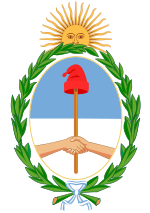Coat of arms of Argentina
| Coat of arms of Argentina | |
|---|---|
 |
|
| Details | |
| Armiger | Argentine Republic |
| Adopted | 1944 (1813) |
| Crest | A Sun of May or |
| Escutcheon | Party per fess azure and argent, in base two arms throughout fessways, the hands shaking and holding a pike paleways proper ensigned on the top with a Phrygian cap gules. |
| Other elements | Around the shield two sprigs of laurel vert tied together in base by a ribbon azure charged with a fess argent |
The coat of arms of the Argentine Republic (Spanish: Escudo de la República Argentina) was established in its current form in 1944, but has its origins in the seal of the General Constituent Assembly of 1813. It is supposed that it was chosen quickly because of the existence of a decree signed on February 22 sealed with the symbol. The first mention of it in a public document dates to March 12 of that same year, in which it is stated that the seal had to be used by the executive power, that is, the second triumvirate. On April 13 the National Assembly coined the new silver and gold coins, each with the seal of the assembly on the reverse, and on April 27 the coat of arms became a national emblem. Although the coat of arms is not currently shown on flags, the Buenos Aires-born military leader Manuel Belgrano ordered to paint it over the flag he gave to the city of San Salvador de Jujuy, and during the Argentine War of Independence most flags had the coat of arms.
It is unknown who designed the coat of arms. It is often mentioned that there were three men involved: Alvear, Monteagudo, and Vieytes, but it is known that a few years before, President Bernardino Rivadavia asked the Peruvian Antonio Isidoro Castro to create an Argentine coat of arms; however, the two schemes have never been found.
The coat of arms is a figure, in which at the top we find the gold-yellowed Sun of May, also found on the flag of Argentina. The rising sun symbolizes the rising of Argentina, as described in the first version of the Argentine National Anthem, se levanta a la faz de la tierra una nueva y gloriosa nación, meaning "a new and glorious nation rises to the surface of the Earth". It must be noticed how the verb "rise", and so in Spanish, can be used to describe the motion of the Sun.
In the center ellipse there are two shaking hands, connoting the unity of the provinces of Argentina. The hands come together to hold a pike, which represents power and willingness to defend freedom, epitomized by the Phrygian cap on the top of the spear.
...
Wikipedia
